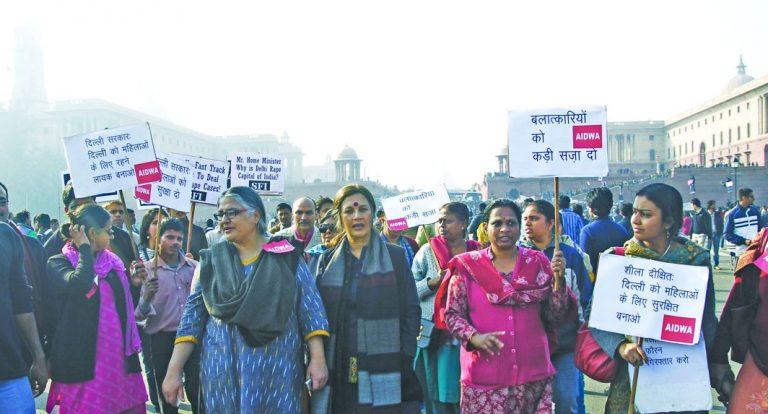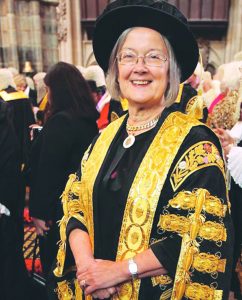
Above: All India Democratic Women’s Association members protest against rising rape cases in Delhi
Increasing rape and gender cases bring to the fore the question whether male and female judges would treat the issues differently. India Legal broaches the subject with a few judges
~By Sujit Bhar
The recent case of an eight-month-old infant being brutally raped by her 28-year-old cousin has shocked society and comes in the backdrop of numerous other such horrendous crimes. It has raised demands for stricter punishment than what the Protection of Children from Sexual Offences Act calls for. The infant is critical and has been shifted to AIIMS for better care.
In such a scenario, it is pertinent to look at how judges react to cases of rape and gender issues coming up before them in court. Would a lady judge treat such a crime and others against women in a more sensitive way as compared to the clinical, dispassionate way of a male judge?
Incidentally, there was only one lady judge in the Supreme Court—Justice R Banumathi—till senior advocate Indu Malhotra became the first woman lawyer to be directly elevated from the bar to the bench in this court. Malhotra will be only the seventh woman judge since Independence to make it to the top court, showing how screwed gender representation is even at the top court.
India Legal spoke to a number of judges, male and female, for their views on how treatment of gender issues varied. While they all said that the inherent impartiality of the system ensured that equal justice was delivered to all, irrespective of gender, there were subtle differences. Male judges were found to be particular about the many legal angles in a case and were often clinical in assessing a crime. Lady judges, they said, had a feminine instinct that could often see right through a man’s defence.
Former Supreme Court Judge Gyan Sudha Misra even cited “aakrosh” (anger) that existed within lady judges which helped them see beyond the surgical precision of their male counterparts. However, it wasn’t as if male judges failed to realise the import of gender-based issues. Former Supreme Court Judge Sujata Manohar referred to the Shah Bano case as an example “of judges overcoming a harsh provision of personal law to give a woman maintenance”. She also cited the top court’s judgment on talaq-e biddat given by an all-male bench.
In the horrendous and hugely publicised Nirbhaya rape and murder case, Justice R Banumathi had hit the nail on the head when she said in her separate judgment: “Offences against women are not a women’s issue alone, but human rights issue.”
At the same time, there is the contrasting judgment of the all-male Kerala High Court bench on an inter-faith marriage. The bench of Justices Surendra Mohan and Abraham Mathew on May 24 last year had ordered that the marriage of two consenting adults, Akhila (alias Hadiya) and Shafin Jahan, was invalid in law and ordered the girl to be taken back to her parents. Chief Justice Dipak Misra had rightly asked that bench whether it could dissolve a marriage between two consenting adults. Would the judgment have been different if the bench had at least one lady judge?
Here are the detailed opinions of four judges India Legal spoke to:
Justice Sujata Manohar, former judge, Supreme Court:
“Impart gender justice education as part of judicial training”
Judgments cannot and should not depend on a judge’s personal views or his/her likes or dislikes. They have to be based on law as applicable to the facts established before a court of law. This judicial process has to be followed by all judges. Hence, in most cases where the facts are clearly established and the applicability of law is clear, there is no difference in the judgments delivered, either by male or female judges.
“It is not easy to eradicate deep-seated patriarchal values or alter traditions that perpetuate discrimination.”
—Justice Sujata Manohar, former judge, Supreme Court
What happens when the law requires to be interpreted, especially those for the protection or empowerment of women? We have the classic example of judgments delivered by male judges (there were hardly any female judges in the higher judiciary then), of interpreting and applying Section 14 of the Hindu Succession Act, 1956 in the late 50s and 60s. The judges construed the Section to give effect to the intention of the legislature to give Hindu women full ownership rights over property.
Where judges are sensitive to women’s issues, they have interpreted the law to uphold women’s rights. The Shah Bano case is another example of judges overcoming a harsh provision of personal law to give a woman her maintenance. The recent Supreme Court judgment on (instant) triple talaq is another example.
It is not, however, easy to eradicate deep-seated patriarchal values or alter traditions that perpetuate discrimination. Cultural traditions, unfortunately, colour decision-making at times. In case of criminal prosecution for a grave crime against a woman, this can amount to the failure of the legal system to deal effectively with violence perpetrated by men on women—be it rape, dowry-related crimes or sexual harassment. However, we do have many instances where male judges who are sensitive to gender issues have given decisions that have greatly supported women.
For example, in Ashok Kumar v State of Rajasthan, the court convicted the brother-in-law of a woman who was burnt to death, and expressed anguish over the evil of dowry. After the infamous decision of the Supreme Court in the Mathura rape case, the Supreme Court held in a later case that a raped woman must be looked upon as an injured person who is a victim of crime and her evidence must be treated as evidence of an injured victim (State of Maharashtra v Chander Prakash).
A new area where the perception of male and female judges may differ if the former are not sensitive to women’s actual experiences is that of sexual harassment. One must not fall into the trap of saying that only women can understand women’s issues. We have a judiciary trained to be objective. But, maybe for such sensitive areas, we need a judiciary trained to be sensitive to gender-related issues. A better representation of women judges in the judiciary can help promote such gender sensitivity.
Not every judge can be expected to be from a cultured part of society. So what is necessary is gender justice education for the judiciary at all levels. It should be a part of the judicial training programmes. Greater inclusion of women in the judicial process as investigators, prosecutors and judges will also lead to better sensitisation of all judges to gender issues and will promote greater balance in the judicial decision-making process.
“I just signed your death warrant”
A US lady judge expresses anger and anguish in a verdict
 The anger of a lady judge in dealing with sexual abuse was seen recently in the US in the case of Larry Nassar, 54, a gymnastics team doctor who worked at Michigan State University and trained Olympians. He had sexually abused more than 150 girls over 25 years and his victims included Olympic medallists Simone Biles, Gabby Douglas and Aly Raisman. One of his youngest victims was Kyle Stephens, who was only six at the time the abuse began.
The anger of a lady judge in dealing with sexual abuse was seen recently in the US in the case of Larry Nassar, 54, a gymnastics team doctor who worked at Michigan State University and trained Olympians. He had sexually abused more than 150 girls over 25 years and his victims included Olympic medallists Simone Biles, Gabby Douglas and Aly Raisman. One of his youngest victims was Kyle Stephens, who was only six at the time the abuse began.
Not only did Judge Rosemarie Aquilina of Ingham County circuit court in Michigan award a 175-year jail sentence to the culprit, Larry Nassar, but she also declared: “I just signed your death warrant.”
Justice Aquilina described the criminal as “precise, calculative, manipulative, devious, despicable”. One would believe that all epithets except “despicable” would have come from a male judge as well. Bolstering her judgment, she said: “…anywhere you walk, destruction will occur.” She also said: “I find that you don’t get it. That you’re a danger. I’m a judge who believes in life, and rehabilitation. But I don’t find that’s possible with you.”
Her feminine side was seen when she addressed the victims: “You are no longer victims. You are survivors.”
Justice Narendra Chapalgaonkar, former judge, Bombay High Court:
“Women judges are more aware but rarely overzealous”
Why should the gender of the judge be relevant in assessing his/her judicial performance or general outlook? As the number of women judges is rising notably, this point appears to have cropped up. Wrong notions about women’s intelligence, born out of male pride, have already been discarded.
“Generally, women judges look at facts and the law in the same manner as their male brethren.”
—Justice Narendra Chapalgaonkar, former judge, Bombay High Court
It is assumed by a few that as women judges are educated in law and the Constitution, their feminine instincts may overshadow their judicial outlook. Fortunately, it doesn’t appear to be true. Women judges are naturally more aware about prevailing injustices against women, but are rarely overzealous.
However, most of them gather sufficient poise while deciding the cause before them. Generally, women judges look at facts and the law in the same manner as their male brethren. As for the flaws that have entered the system, no exception can be carved out on the basis of gender.
Justice DM Dharmadhikari, former judge, Supreme Court:
“Male judges are often over-sensitive in gender conflict cases”
It is a legislative myth in the working of family and penal laws that only female judges can effectively dispense justice to women in conflict with men. There are many examples which show that female judges have given justice to males in conflict with women and vice-versa.
“In family matters and offences involving women, courts should comprise both male and female judges.”
—Justice DM Dharmadhikari, former judge, Supreme Court
The recent case of a complaint against a judge of a high court by a lady judge of a subordinate court due to alleged indecent behaviour was cleared by the committee constituted by the Supreme Court. It comprised a sitting female judge of the Supreme Court. The lady judge of the subordinate court pursued the matter and a parliamentary committee under the Judges Inquiry Act was constituted which comprised two lady judges of superior courts. That committee also cleared the High Court judge. This makes it apparent that male judges of the apex court had adopted a hyper-sensitive approach in the matter and caused immense damage to the reputation of the High Court judge. He had to suffer mental and physical agony caused by an aspersion on his reputation and character for which there is no compensation in law.
Similarly, a judge of the Supreme Court had to suffer great mental harassment on the allegation of an intern, where again the hyper-sensitivity shown by male judges could be seen and ultimately, the accusation was found to be not worth an inquiry. These show that male judges show over-sensitiveness many times towards the cause of women and vice-versa.
There are provisions in family laws and Protection of Women from Domestic Violence Act that in cases arising under these enactments, as far as possible, the presiding judges should be women and so also the family counsellors. When workshops and conferences of female judges presiding in family courts are held, they share their experiences. In many cases, once a marriage has broken down or there is a breach in the marriage relationship, the alleged woman victim becomes revengeful and vindictive, so much so that she involves innocent relatives of the husband.
In matrimonial cases where the husband is living in one state and the wife in another, the power to transfer the case to the place of residence of the wife is readily granted by male judges of the Supreme Court without considering the harassment and inconvenience it might cause the husband.
Experience shows that male judges become over-sensitive and women judges fall back on their experience as females in such cases. In family matters and offences involving women, courts should comprise both male and female judges and wherever possible, NGOs working in the field and having male and female members should be allowed to assist the court in reconciliation.
The Hale Doctrine
UK’s first woman SC president sees gender equality as a fitting legacy
 The first and only woman to become a law lord, one of 12 in the UK’s judicial system, Brenda Hale was the only female justice until she recently became the Supreme Court’s third president. Hale has been known to refer to “my brand of feminism”, and many in the judiciary speak about a Hale Doctrine which assumes that issues surrounding gender equality could eventually prove to be her biggest legacy.
The first and only woman to become a law lord, one of 12 in the UK’s judicial system, Brenda Hale was the only female justice until she recently became the Supreme Court’s third president. Hale has been known to refer to “my brand of feminism”, and many in the judiciary speak about a Hale Doctrine which assumes that issues surrounding gender equality could eventually prove to be her biggest legacy.
In one of Hale’s best remembered decisions, Yemshaw v Hounslow, a woman had left the family home with her two young children in response to her husband’s abusive behaviour, but the council—and the Court of Appeal—found that she didn’t qualify as a person suffering domestic “violence” because her husband had never physically attacked her.
“Was this,” Hale asked, “a classic case of domestic abuse, in which one spouse puts the other in fear through the constant denial of freedom and of money for essentials, through the denigration of her personality, such that she genuinely fears that he may take her children away from her however unrealistic this may appear to an objective outsider?” Hale’s decision expanded the definition of domestic violence, laying the way for a broader understanding that prevails today.
Justice Gyan Sudha Misra, former judge, Supreme Court:
“Lady judges feel more anger in gender-related cases”
Once, when I was a part of a high court bench, a rape case of a four-year-old came before us and I had a difference of opinion with my male counterpart. That was the one time when I felt that maybe the amount of “aakrosh” (anger) that develops in the mind of a lady judge is more than in a male judge in a gender-related case. I am not sure how a male judge would feel in a rape case, but as a woman, I would think: “How did this happen, why did this happen?”
Male judges, too, get angry, but they look at it dispassionately, quite like a surgical procedure to treat the “disease”. They study the evidence and then deal with it in a mathematical precise manner. But when it comes to the psychological aspect, a lady judge thinks more about the how and why of the issue.
“Male judges too get angry, but they look at it dispassionately, quite like a surgical procedure to treat the ‘disease’.”
—Justice Gyan Sudha Misra, former judge, Supreme Court
During the rape case of the four-year-old—she subsequently died—I noticed the psychological aspect of the rapist. He had been given the death sentence by the trial court. But I saw that he was supposed to get married soon, and despite that, he had lured this child with balloons and chocolates and raped her.
We had overturned the death sentence on him, but the way my male counterpart on the bench saw it was a 2+2 situation where evidence was matched leading to an implication. But I differed. While he did commit the crime, I felt that he did not think or plan it.
Even among men, there are different viewpoints. You cannot typecast all males as one. But the attitude generally is: “Ab choriye, kya hota hai… thik hai dekh liya (Let’s leave it, it has been resolved).”
Without taking any names, I want to refer to a case where an IAS officer in Chandigarh had filed a case because she was given a “pat on the back” (by a senior police officer). My reaction to that was again how did this happen and why did it happen? But male colleagues said: “Arre aap mahilaein bas youn hi har cheez ka bounder bana dete hain (You women make a mountain out of a molehill.)”
In another rape case (the rape happened in 1997 and the judgment came in 2011) which came up before the Supreme Court, we allowed the rapist to pay compensation to the victim in lieu of punishment. But a newspaper questioned this judgment and asked: “How could this happen when a lady judge was on the bench?” I again felt the same “aakrosh” in my mind, but I had to consider that 14 years had passed and both the parties were agreeable. Hence, it depends on how one looks at a case, male or female.

